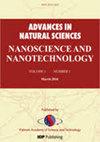Amino-functionalized graphene quantum dots as a photoluminescent probe for in vitro cellular imaging of human lung cancer cell lines
IF 2.1
Q3 MATERIALS SCIENCE, MULTIDISCIPLINARY
Advances in Natural Sciences: Nanoscience and Nanotechnology
Pub Date : 2024-05-27
DOI:10.1088/2043-6262/ad4852
引用次数: 0
Abstract
Graphene-based fluorescent materials, particularly graphene quantum dots (GQDs), have emerged as a new class of biomedical agents. In the present study, functionalised GQDs have a better chance of being employed in a broader range of bioapplications because of their proven low toxicity, outstanding biocompatibility, and enhanced fluorescence properties. For this purpose, amino-functionalised GQDs (AF-GQDs) were synthesised via hydrothermal treatment by treating graphene oxide in ammonia with heat and water. The as-prepared AF-GQDs samples were characterised using a variety of techniques, including x-ray diffraction analysis (XRD), high-resolution transmission electron microscopy (HR-TEM), and photoluminescence (PL) spectroscopy. The results show that AF-GQDs are merely hexagonal, with an average size of about 8 nm. Also, AF-GQDs are highly soluble in water and display excellent luminescence behaviour. After 48 h of incubation, the MTT results showed that more than 63% of the cells were still alive, even at high concentrations (500 g ml−1) of AF-GQDs. In addition, the AO/EB staining results also showed that the AF-GQDs had the most robust green fluorescence (viable cells). This makes them a promising agent for biomedical imaging because they have good optical properties, are readily soluble in water, are biocompatible, and are not toxic.作为光致发光探针的氨基功能化石墨烯量子点,用于人类肺癌细胞系的体外细胞成像
基于石墨烯的荧光材料,尤其是石墨烯量子点(GQDs),已成为一类新型的生物医学制剂。在本研究中,功能化石墨烯量子点因其公认的低毒性、出色的生物相容性和增强的荧光特性,更有可能被用于更广泛的生物应用。为此,我们通过水热处理法合成了氨基功能化 GQDs(AF-GQDs)。利用多种技术对制备的 AF-GQDs 样品进行了表征,包括 X 射线衍射分析 (XRD)、高分辨率透射电子显微镜 (HR-TEM) 和光致发光 (PL) 光谱。结果表明,AF-GQDs 只是六边形,平均尺寸约为 8 纳米。此外,AF-GQDs 在水中的溶解度很高,并显示出优异的发光性能。培养 48 小时后,MTT 结果显示,即使在高浓度(500 g ml-1)AF-GQDs 的情况下,仍有超过 63% 的细胞存活。此外,AO/EB 染色结果也显示,AF-GQDs 发出的绿色荧光(存活细胞)最强。这使它们成为一种很有前景的生物医学成像剂,因为它们具有良好的光学特性、易溶于水、生物相容性好且无毒。
本文章由计算机程序翻译,如有差异,请以英文原文为准。
求助全文
约1分钟内获得全文
求助全文
来源期刊

Advances in Natural Sciences: Nanoscience and Nanotechnology
NANOSCIENCE & NANOTECHNOLOGYMATERIALS SCIE-MATERIALS SCIENCE, MULTIDISCIPLINARY
自引率
4.80%
发文量
0
 求助内容:
求助内容: 应助结果提醒方式:
应助结果提醒方式:


